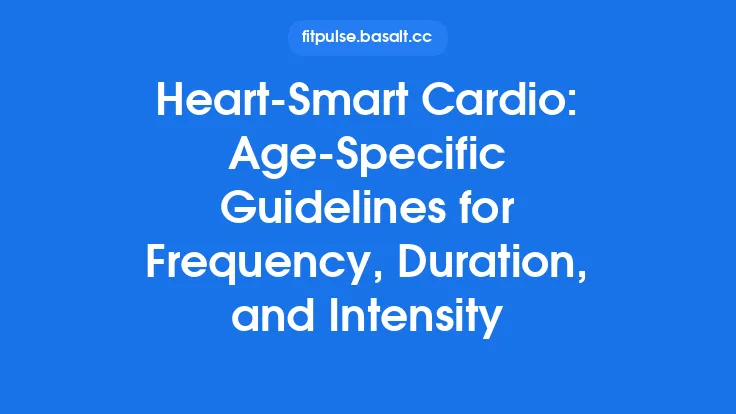Youth fitness programming is most effective when it respects the unique physiological, biomechanical, and psychosocial characteristics of each developmental stage. By aligning movement selection, volume, intensity, and progression with age‑appropriate capabilities, coaches, teachers, and parents can foster lifelong habits of physical activity while minimizing injury risk. The following guide outlines the core principles and practical tools needed to design safe, engaging, and progressive fitness experiences for children and adolescents.
Developmental Foundations
1. Growth and Maturation Timelines
- Preschool (3‑5 years): Rapid neural development, limited skeletal ossification, high flexibility, and a natural propensity for play‑based movement.
- Early School Age (6‑9 years): Improved coordination, emerging strength, and the beginning of linear growth spurts.
- Pre‑Adolescence (10‑12 years): Onset of puberty, increased muscle mass, and heightened neuromuscular efficiency.
- Adolescence (13‑18 years): Accelerated hormonal changes, peak bone mineral density accrual, and the capacity for higher absolute loads.
Understanding where a child falls on this continuum informs the selection of movement patterns, load magnitude, and progression speed.
2. Motor Skill Development Stages
- Fundamental Movement Skills (FMS): Running, jumping, throwing, catching, and balancing. Mastery of FMS provides the building blocks for more complex sport‑specific actions.
- Skill Refinement: Between ages 8‑12, children transition from “basic” to “refined” execution, allowing for the introduction of multi‑planar and plyometric elements.
- Sport‑Specific Integration: From age 13 onward, athletes can safely incorporate higher‑velocity, sport‑specific drills that demand greater neuromuscular control.
Physiological Considerations
1. Muscular Strength vs. Power
- Strength: In youth, absolute strength gains are modest; improvements are largely driven by neural adaptations (motor unit recruitment, firing frequency).
- Power: Power development becomes more relevant after age 12 when muscle cross‑sectional area increases. Plyometric and ballistic training should be introduced gradually, respecting joint maturity.
2. Cardiovascular Capacity
- Aerobic capacity (VO₂max) peaks in late adolescence. Endurance sessions for younger children should emphasize interval play (e.g., tag, obstacle courses) rather than continuous steady‑state running.
3. Skeletal and Connective Tissue Maturity
- Growth plates (physes) are vulnerable to high compressive forces. Load prescriptions must avoid excessive axial loading, especially in pre‑pubescent athletes. Emphasize bodyweight, resistance bands, and light free‑weight exercises with proper technique.
Load Prescription Principles
| Parameter | Preschool (3‑5) | Early School (6‑9) | Pre‑Adolescence (10‑12) | Adolescence (13‑18) |
|---|---|---|---|---|
| Intensity | Light (≤30 % of perceived effort) | Light‑moderate (30‑50 %) | Moderate (40‑60 %) | Moderate‑high (50‑70 %) |
| Volume | 1‑2 sets, 5‑10 reps (bodyweight) | 2‑3 sets, 8‑12 reps | 2‑4 sets, 8‑15 reps | 3‑5 sets, 6‑12 reps (including load) |
| Rest | Playful transitions (30‑60 s) | 60‑90 s | 60‑120 s | 90‑180 s for strength; 30‑60 s for power |
| Frequency | 2‑3 sessions/week (short, 15‑20 min) | 2‑3 sessions/week (20‑30 min) | 3‑4 sessions/week (30‑45 min) | 3‑5 sessions/week (45‑60 min) |
Key Guidelines
- Progressive Overload: Increase one variable at a time (e.g., add a rep, then a set, then a modest load).
- Load Quantification: Use “RPE” (Rate of Perceived Exertion) scales adapted for children (e.g., 0‑10 “fun” scale) and simple objective measures (e.g., “how many jumps can you do without stopping?”).
- Technical Mastery First: Load is secondary to movement quality. Only add external resistance once the child can perform the movement pattern with ≥90 % technical proficiency across three consecutive sessions.
Sample Programming Frameworks
1. Preschool Play‑Based Fitness (3‑5 years)
- Warm‑up (5 min): Animal walks (bear crawl, crab walk), dynamic stretching through story narration.
- Core Movement Circuit (10 min):
- Jumping Jacks – 2 × 10 reps
- Balance Beam (tape on floor) – 2 × 10 sec each foot
- Throwing Soft Balls – 2 × 5 throws to a target
- Cool‑down (5 min): Guided breathing and gentle stretching.
Load: No external load; focus on body awareness and enjoyment.
2. Early School Age Strength & Skill (6‑9 years)
- Frequency: 2 × week, 30 min/session.
- Structure:
- Dynamic Warm‑up (5 min) – high‑knees, butt kicks, arm circles.
- Fundamental Skill Block (10 min) – squat to sit‑to‑stand, push‑up progression (wall → knee → full).
- Resistance Band Circuit (10 min) – band rows, band chest press, band hip abduction (2 × 12 reps each).
- Game‑Based Conditioning (5 min) – relay races, tag variations.
- Progression: Add a band of higher resistance after 2‑3 weeks of consistent technique.
3. Pre‑Adolescent Power & Conditioning (10‑12 years)
- Frequency: 3 × week, 45 min/session.
- Components:
- Mobility & Activation (5 min) – foam roll, dynamic lunges.
- Strength Block (15 min) – goblet squat (light kettlebell), dumbbell deadlift (2 × 8‑10 reps).
- Plyometric Introduction (10 min) – squat jumps, lateral bounds (2 × 6 reps each direction).
- Skill Integration (10 min) – dribbling drills, medicine‑ball throws.
- Cool‑down (5 min) – static stretch, breathing.
- Load Guidelines: Kettlebell weight ≤ 25 % of body mass; focus on landing mechanics (soft knees, hip hinge).
4. Adolescent Performance Programming (13‑18 years)
- Frequency: 4‑5 × week, 60 min/session (split into strength, power, endurance, and sport‑specific days).
- Typical Weekly Layout:
- Day 1 – Lower‑Body Strength: Back squat (3 × 5, 60‑70 % 1RM), Romanian deadlift (3 × 8), core circuit.
- Day 2 – Upper‑Body Power: Push‑press (3 × 4), medicine‑ball slams (3 × 6), plyometric push‑ups (3 × 5).
- Day 3 – Aerobic Conditioning: Interval runs (30 s high, 60 s low, 8 × ).
- Day 4 – Sport‑Specific Skills: Agility ladder, change‑of‑direction drills, sport‑specific drills.
- Day 5 – Active Recovery / Mobility: Yoga, light swimming, foam rolling.
- Periodization: Employ macro‑cycles (12 weeks) divided into 3‑week “accumulation” (higher volume, lower intensity) and 1‑week “intensification” (lower volume, higher intensity) phases, followed by a deload week.
Safety, Monitoring, and Feedback
1. Pre‑Participation Screening
- Use a simplified health questionnaire (e.g., “Do you have any current injuries or medical conditions that limit activity?”).
- Conduct a brief movement screen (e.g., overhead squat, single‑leg balance) to identify asymmetries.
2. Technique Cueing
- Employ visual demonstrations, tactile feedback, and age‑appropriate language (“keep your knees over your toes”).
- Use “stop‑and‑fix” moments: pause the set, correct form, then resume.
3. Load Monitoring Tools
- RPE/“Fun” Scale: 0 = no effort, 10 = maximum effort.
- Heart Rate Zones: For adolescents, 70‑85 % of max HR (220 − age) during conditioning.
- Performance Logs: Simple charts tracking reps, sets, and perceived difficulty.
4. Injury Prevention
- Emphasize warm‑up specificity, progressive loading, and adequate rest.
- Teach proper landing mechanics (soft knees, hip flexion) before introducing plyometrics.
- Ensure equipment (e.g., resistance bands, kettlebells) is age‑appropriate and inspected regularly.
Psychological and Social Dimensions
- Intrinsic Motivation: Frame sessions as “games” or “challenges” rather than “workouts.” Offer choices (e.g., “Do you want to do the obstacle course or the relay?”).
- Goal Setting: Use short‑term, measurable goals (“Complete 10 push‑ups with good form”) and celebrate achievements publicly.
- Peer Interaction: Pair or group activities foster cooperation, accountability, and enjoyment.
- Self‑Efficacy: Provide frequent positive feedback and highlight skill improvements, which builds confidence for future sport participation.
Integration with School and Community Settings
- Curriculum Alignment: Map fundamental movement skills to national physical education standards; embed fitness blocks within existing PE lessons.
- After‑School Programs: Offer tiered sessions (beginner, intermediate, advanced) that mirror the age‑appropriate progression outlined above.
- Family Involvement: Distribute home‑activity sheets that encourage parents to model active behavior and reinforce skill practice.
- Resource Utilization: Leverage low‑cost equipment (resistance bands, medicine balls, cones) to create versatile stations adaptable to any space.
Nutrition Basics for Growing Athletes
- Energy Balance: Ensure caloric intake matches growth demands and activity level; under‑fueling can impair recovery and growth.
- Macronutrient Distribution:
- Carbohydrates: 45‑65 % of total calories for energy.
- Protein: 1.0‑1.4 g/kg body weight per day to support muscle repair.
- Fats: 25‑35 % of calories, emphasizing unsaturated sources.
- Hydration: Encourage water consumption before, during, and after activity; educate on recognizing thirst cues.
Assessment and Progress Tracking
| Assessment Tool | Age Range | Frequency | What It Measures |
|---|---|---|---|
| Fundamental Movement Skills Test (FMST) | 5‑12 y | Baseline + every 6 mo | Proficiency in locomotor, object control, stability skills |
| 1‑RM Estimation (Submaximal) | 13‑18 y | Every 8‑12 wks | Strength capacity (use 5‑RM to predict 1‑RM) |
| Vertical Jump Test | 10‑18 y | Quarterly | Power development |
| Yo-Yo Intermittent Recovery Test | 12‑18 y | End of season | Aerobic endurance |
| Body Composition (Skinfolds or BIA) | 8‑18 y | Annually | Growth trends, lean mass changes |
Document results in a simple spreadsheet, plot trends, and discuss findings with the youth athlete to reinforce progress and adjust programming as needed.
Frequently Asked Questions
Q: When is it safe to introduce free weights?
A: Light free weights (≤ 5 kg) can be introduced once a child demonstrates consistent mastery of bodyweight movements (e.g., squat, hinge, push‑up) and has proper spinal alignment awareness, typically around age 9‑10. Progression should remain load‑centric on technique, not on maximal weight.
Q: How much rest is needed between strength sessions for adolescents?
A: At least 48 hours of targeted muscle group recovery is recommended. Full‑body sessions can be spaced 2‑3 days apart; split routines allow 24‑48 hours between sessions for the same muscle group.
Q: Should youth athletes perform high‑intensity interval training (HIIT)?
A: HIIT can be incorporated for adolescents (13‑18 y) once a solid aerobic base is established. Sessions should be ≤ 20 minutes, with work intervals ≤ 30 seconds and active recovery ≥ 60 seconds, and limited to 2‑3 times per week.
Q: Is it necessary to periodize youth training?
A: Yes, periodization helps balance load, prevent overuse injuries, and align training peaks with competition or school sport seasons. Simple linear or block periodization models are sufficient for most youth programs.
Q: How can coaches keep sessions fun while still progressive?
A: Use game‑based formats (e.g., “beat the clock,” “team challenges”), rotate stations to maintain novelty, and embed skill progression within the narrative of the game (e.g., “level up” after mastering a movement).
Closing Thoughts
Designing youth fitness programs that respect age‑appropriate movement patterns and load capacities is both an art and a science. By grounding programming decisions in developmental physiology, employing clear progression frameworks, and fostering a supportive, enjoyable environment, practitioners can nurture healthy, competent, and motivated young athletes. The principles outlined here are timeless; they can be adapted to any setting—school gym, community center, or home backyard—ensuring that every child has the opportunity to move confidently, safely, and joyfully throughout their formative years.





